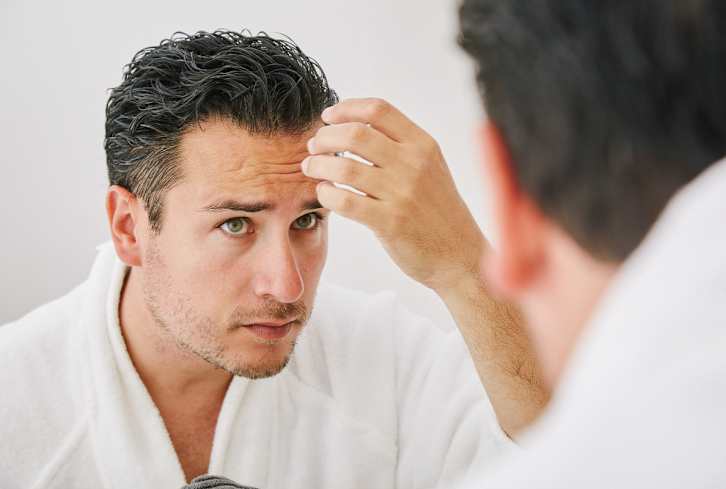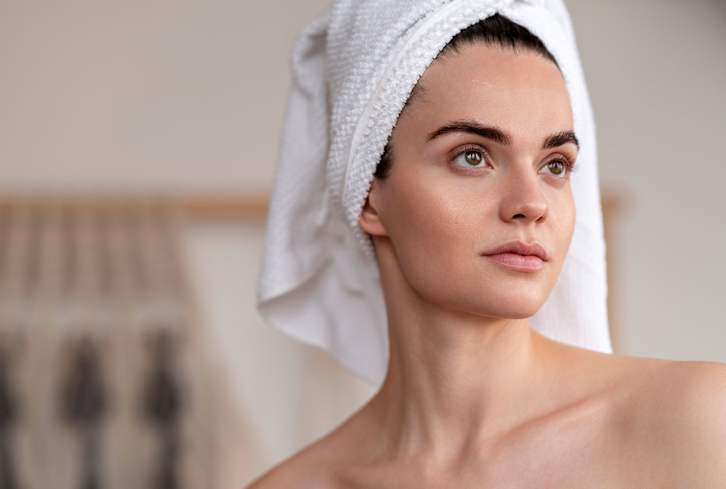Advertisement
Acne Face Map: What Your Skin Breakouts Are Telling You


For most of us, thinking about the underlying causes of acne can often feel like a guessing game that we'll never get the final answers to. Was it brought on by stress? Hormones? Food? All of these things? According to some, however, the facial area in which you experience acne may be able to offer clues as to what may be causing it.
This practice is known as acne face-mapping. Because science has yet to fully back up these claims, face-mapping is controversial in the dermatologic world—but that's not to say that the type of acne you're experiencing doesn't offer its own clues, too.
Here, we explain the idea of face-mapping, including its origins and general beliefs, plus explore the many science-backed ways in which the type of blemish can offer real clues into what's going on beneath the surface.

Face-mapping: Where are you breaking out and what does it mean?
"Those who practice acne face-mapping believe that the pimples that form in the same part of your face each month are correlated to an underlying internal issue," explains Devika Icecreamwala, M.D., a dermatologist in Berkeley, California. In ayurveda, the acne face-map is divided into different areas, called zones, each of which signals a different underlying issue, whether it be internal or external.
Forehead and nose
Also known as the T-zone, this area of the face experiences an elevated level of oil compared to the rest of the complexion, thanks to the greater number of sebaceous glands that lie beneath the skin's surface.
In ayurvedic face-mapping, this area of the face is commonly tied to stagnation in the nervous and digestive systems; that is, digestive issues and stress-inducing experiences, such as lack of sleep or periods of high emotion, can ignite acne in these areas.
Another kind of "acne" that appears on the forehead, is something commonly called "fungal acne." However, it's important to know that this isn't actually acne—rather a type of folliculitis (inflammation of the hair follicle) that happens when yeast becomes trapped inside of hair follicles, leading to pimple-like bumps. Read more about fungal acne here.
Cheeks
In ayurveda, it's thought that "cheek acne could indicate problems in the lungs," Icecreamwala says, although she is quick to point out that again here, "there is no scientific evidence to support this."
Acne in this area can also be triggered by lifestyle factors. For example, "those who hold their phone up to their cheek a lot can develop acne where the screen contacts the face," Icecreamwala explains.
Other potentially acne-inducing habits include sleeping on dirty pillowcases (aim to change them at least once per week) and touching your face throughout the day with dirty fingers.
Redness and breakouts on the cheeks are also a common symptom of rosacea—something that's often confused with acne. If you having been treating your breakouts in the area with typical acne treatments and it hasn't helped, consider visiting a dermatologist who can identify signs of rosacea and offer better treatment solutions.
Jaw and chin
According to ayurvedic face-mapping, acne on the chin and along the jawline is thought to be triggered by hormones. Unlike other areas of the face, there is scientific research out there that supports this chin-hormone connection. According to one study, it is well established that hormonal acne tends to concentrate within the lower third of the face1.
"This does not mean that there are hormonal irregularities in your blood," Icecreamwala explains. "It means that your oil glands are more sensitive to hormones that your body naturally produces." The primary hormones thought to incite this type of acne include estrogens, progesterone, growth hormone, and androgens.
Meet the Expert
Breakout types and what it means
Although ayurvedic face-mapping is considered controversial, it is well recognized that the type of acne you experience—whether it be blackheads, cystic, or anything in between—can usually give you clues about why your breakouts are happening as well as what to do about it.
Blackheads
Stubborn blackheads form when hair follicles become clogged with excess oil and dead skin cells. When that debris is not properly cleansed off, "the sebum undergoes a chemical reaction, which turns it into a black color," Icecreamwala explains. The underlying causes of blackheads vary, and these dreaded black dots can show up just about anywhere—including on the back, chest, and arms—although they are most commonly found on the nose.
Blackheads can be brought on by skin that simply produces too much oil, which often takes place during times of hormonal changes, such as pregnancy, menstruation, or teenage years.
The key to preventing and treating blackheads is to properly and sufficiently cleanse your skin, including regular gentle exfoliation, which will swipe away those potentially problematic dead skin cells. Oftentimes, for cases of extra stubborn blackheads, dermatologists recommend the use of topical salicylic acid, retinoids, and even extractions.
Whiteheads
The most common cause of whiteheads, which are technically called "closed comedones," is similar to their black-colored counterparts: clogged pores, whether from excess oil, dead skin cells or a combination thereof.
Treating whiteheads, and preventing their return, is therefore often focused on unclogging pores—usually with some type of exfoliating cleanser, either physical or chemical. Like blackheads, this overproduction of oil is often tied to a hormonal shift or consuming dairy2.
Papules & Pustules
Papules and pustules, the stereotypical red-colored blemish you likely think of when you picture acne, is caused when another intruder enters an already-clogged pore. "Pimples and pustules develop when bacteria overgrow in the pores that are clogged with sebum," Icecreamwala explains. Papules often turn into pustules: The former is characterized by red, inflamed, and sore skin. When this red bump forms a white, pus-filled head, its known as a pustule.
Nodules
Acne nodules can be thought of as a more severe, and serious, pustule. They form deeper within the skin when the follicle wall breaks and the backed-up debris spills out into the skin. This type of acne is also painful—you'll be able to tell the difference because you'll feel it—and it should always be treated by a dermatologist.
Cysts
Even more painful than nodules, cystic acne is considered to be the most severe type of acne. It's characterized by inflamed lesions, often large in size, that form deep within the skin—but. unlike other forms of acne, they never come to a head on the surface.
Often, cystic acne is the result of large hormonal imbalances. Cystic acne should also always be treated by a board-certified dermatologist, and the very worst thing you can do for cystic breakouts is to touch, squeeze, or try to pop the lesions.
What can you do to heal your acne?
Healing your skin is possible. If you want a full list of glow-boosting recommendations, here are our best skin care tips to follow: It covers everything from diet and exercise to vitamin C serums and what SPF to pick. But if you want to start internally, these five tips are the best place to start:
- Eat a low-inflammation diet: Since we know that inflammation can wreak havoc on the body and skin, leading to breakouts3, make sure to keep your overall inflammation low with a diet rich with dark greens, fruits, colorful veggies, lean proteins, and healthy fats.
- Eliminate refined sugar and dairy: From research, we know that two of the biggest acne-causing culprits are dairy2 and foods high in sugar (aka foods that rate high on the glycemic index).
- Heal your gut: The gut-skin axis is strong4, so be mindful of how you are caring for your gut microbiome. Eat plenty of fermented foods, and consider a probiotic supplement.
- Manage your stress: Stress has been shown to trigger hormone imbalances in the body5, which leads to breakouts. Activities like yoga, meditation, and more exercise reduce everyday stress and boost your energy and mood.
- Support with antioxidants and adaptogens: Antioxidants neutralize free radicals and quench minor inflammation—in the process they stop a cascade of destructive damage. Adaptogens are effective herbal tonics that can help handle oxidative stress by restoring the body's homeostasis when undergoing stress, which means they have the ability to balance and stabilize the body's systems. They also possess anti-inflammatory properties. You can use these both topically and through supplementation.
The takeaway
The type of acne you experience can tell you a lot—including how to treat it and when to see a dermatologist. While the ayurvedic practice of acne face-mapping has yet to be proved by science, when battling breakouts of any kind, we can't help but think that it doesn't hurt to consider all of the potential causes—even those backed by ancient anecdotes.
Watch Next
Enjoy some of our favorite clips from classes
Enjoy some of our favorite clips from classes
What Is Meditation?
Mindfulness/Spirituality | Light Watkins
Box Breathing
Mindfulness/Spirituality | Gwen Dittmar
What Breathwork Can Address
Mindfulness/Spirituality | Gwen Dittmar
The 8 Limbs of Yoga - What is Asana?
Yoga | Caley Alyssa
Two Standing Postures to Open Up Tight Hips
Yoga | Caley Alyssa
How Plants Can Optimize Athletic Performance
Nutrition | Rich Roll
What to Eat Before a Workout
Nutrition | Rich Roll
How Ayurveda Helps Us Navigate Modern Life
Nutrition | Sahara Rose
Messages About Love & Relationships
Love & Relationships | Esther Perel
Love Languages
Love & Relationships | Esther Perel
What Is Meditation?
Box Breathing
What Breathwork Can Address
The 8 Limbs of Yoga - What is Asana?
Two Standing Postures to Open Up Tight Hips
How Plants Can Optimize Athletic Performance
What to Eat Before a Workout
How Ayurveda Helps Us Navigate Modern Life
Messages About Love & Relationships
Love Languages
Advertisement

Research Shows Vitamin Deficiency May Up Alzheimer's Risk By 59%
Molly Knudsen, M.S., RDN

Research Shows Vitamin Deficiency May Up Alzheimer's Risk By 59%
Molly Knudsen, M.S., RDN

Research Shows Vitamin Deficiency May Up Alzheimer's Risk By 59%
Molly Knudsen, M.S., RDN

Research Shows Vitamin Deficiency May Up Alzheimer's Risk By 59%
Molly Knudsen, M.S., RDN









